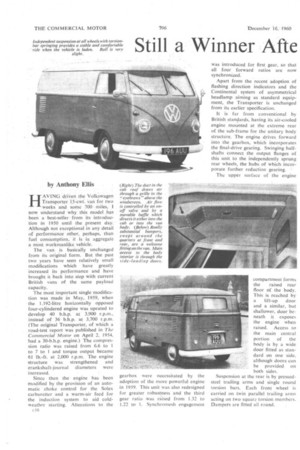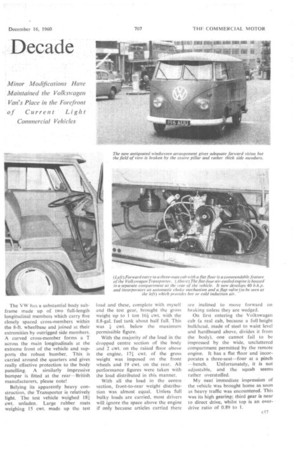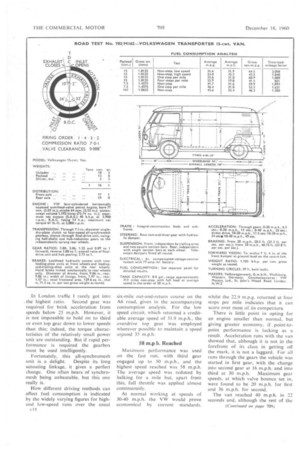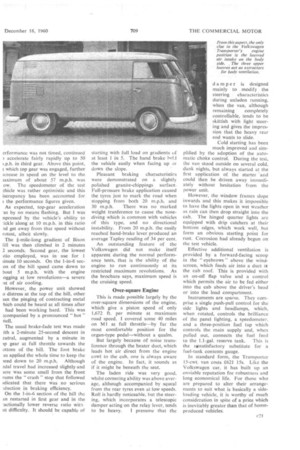Still a Winner Afte
Page 52

Page 53

Page 54

Page 57

If you've noticed an error in this article please click here to report it so we can fix it.
1)ecade
Minor Modifications Have Maintained the Volkswagen Van's Place• in the Forefront of Current Light
.Commercial Vehicles
by Anthony Ellis
•
HAVING cltiiien the Volkswagen Transporter..15-cwf. van for two weeks and some .700• miles, ..I now under,stand why-. this model has been a best-seller from its introduction in 1950 until the present day. Although not exceptional in any detail of performance other, perhaps, than fuel. consurtiption; it is in aggregate
most workmanlike vehicle.
The . van, is basically unchanged from its, original form. But the past two years have seen relatively small modifications which have greatly increased its performance and have brought it back into step with current British vans of the same payload capacity.
The most important single modification was made in May, 1959, when the 1.192-litre horizontally opposed four-cylindered engine was uprated to develop 40 b.b.p. at 3,900 r.p.m., instead of 36 b.h.p. at 3,700 r.p.m. (The original Transporter, of which a road-test .repart was published in The Commercial Motor on April 2, 1954, had a 30-b.h.p. engine.) The compression ratio was raised from 6.6 to 1 to 7 to 1 andtorque output became 61 lb.-ft. at 2,000 r.p.m. The engine structure was strengthened and crankshaft-journal diameters were increased.
Since then the engine has been modified by the provision of an automatic choke control for the Solex carburetter and a warm-air feed for the induction system to aid coldweather starting. Alterations to the
gearbox were necessitated by the adoption of the more powerful engine in 1959. This unit was also redesigned for greater robustness and the third gear ratio was raised from 1.32 to 1,22 to I. Synchromesh engagement
was introduced for first gear, so that all four forward ratios are now synchronized.
Apart from the recent adoption of flashing direction indicators and the Continental system of asymmetrical headlamp aiming as standard equipment, the Transporter is unchanged from its earlier specification.
It is far from conventional by British standards, having its air-cooled engine mounted at the extreme rear of the sub-frame for the unitary body structure. The engine drives forward into the gearbox, which incorporates the final-drive gearing. Swinging halfshafts connect the output flanges of this unit to the independently sprung rear wheels, the hubs of which incorporate further reduction gearing.
The upper surface of the engine compartment forms the raised rear floor of the body. This is reached by a lift-up door and a similar, but shallower, door beneath it exposes the engine when raised. Access to the main central portion of the body is by a wide door fitted as standard on one side, although doors can be provided on both sides.
Suspension at the rear is by pressedsteel trailing arms and single round torsion bars. Each front wheel is carried on twin parallel trailing arms acting on two squaro torsion members. Dampers are fitted all round. The VW has a substantial body subframe made up of two full-length longitudinal members which carry five closely spaced cross-members within the 8-ft. wheelbase and joined at their extremities by outrigged side members. A curved cross-member forms a T across the main longitudinals at the extreme front of the vehicle and supports the robust bumber. This is carried around the quarters and gives really effective protection to the body panelling. A similarly impressive bumper is fitted at the rear—British manufacturers, please note!
Belying its apparently heavy construction, the Transporter is relatively light. The test vehicle weighed 181 cwt. unladen. Large rubber mats weighing 15 cwt. made up the test load and these, complete with myself and the test gear, brought the gross weight up to 1 ton l6J, cwt., with the 8.8-gal. fuel tank about half full. This was + cwt. below the maximum permissible figure.
With the majority of the load in the dropped centre section of the body and 2 cwt. on the raised floor above the engine, 17+ cwt. of the gross weight was imposed on the front wheels and 19 cwt. on the rear. All performance figures were taken with the load distributed in this manner.
With all the load in the centre section, front-to-rear weight distribution was almost equal. Unless full bulky loads are carried, most drivers will ignore the space above the engine if only because articles carried there are inclined to move forward on braking unless they are wedged.
On first entering the Volkswagen cab (a real cab, because a full height bulkhead, made of steel to waist level and hardboard above, divides it from the body), one cannot fail to be impressed by the wide, uncluttered compartment permitted by the remote engine. It has a flat floor and incorporates a three-seat—four at a pinch --bench. Unfortunately, it is not adjustable, and the squab seems rather overstuffed.
My next immediate impression of the vehicle was brought home as soon as heavy traffic was encountered. This was its high gearing: third gear is near to direct drive, whilst top is an overdrive ratio of 0.89 to 1.
In London traffic 1 rarely got into , the highest ratio. Second gear was required for brisk acceleration from speeds below 25 m.p.h. However, it is not impossible to hold on to third or even top gear down to lower speeds than this; indeed, the torque characteristics of the relatively small power unit are outstanding. But if rapid performance is required the gearbox must be used intelligently.
Fortunately, this all-synchromesh unit is a delight. Despite its long actuating linkage, it gives a perfect change. One often hears of synchromesh being unbeatable, but this one really is.
How different driving methods can affect fuel consumption is indicated by the widely varying figures for highand low-speed runs over the usual
cIS
six-mile out-and-return course on the A6 road, given in the accompanying consumption analysis. For the low speed circuit, which returned a creditable average speed of 31.9 m.p.h., the overdrive top gear was employed wherever possible to maintain a speed arpund 35 m.p.h.
58 m.p.h. Reached
Maximum performance was used on the fast run, with third gear engaged up to 50 m.p.h., and the highest speed reached was 58 m.p.h. The average speed was reduced by balking for a mile but, apart from this, full throttle was applied almost continuously.
At normal working at speeds of 30-40 m.p.h. the VW would prove economical by current standards, whilst the 22.9 m.p.g. returned at four stops per mile indicates that it can score over most of its competitors.
There is little point in opting for an engine smaller than normal, but giving greater economy, if, point-topoint performance is lacking as a result. Acceleration runs with the van showed that, although it is not in the forefront of its class in getting off the mark, it is not a laggard. For all runs through the gears the vehicle was started in first gear, with the change into second gear at 16 m.p.h. and into third at 30 m.p.h. Maximum gear speeds, at which valve bounce set in, were found to be 20 m.p.h. for first and 36 m.p.h. for second.
The van reached 40 m.p.h. in 22 seconds and, although the rest of the (Continued on page 709)
erformance was not timed, continued ) accelerate fairly rapidly up to 50 1.p.h. in third gear. Above this point, t which top gear was engaged, further [crease in speed on the level to the
iaximurn of. about 57 m.p.h. was ow. The speedometer of the test ehicle was rather optimistic and this iscrepancy has been accounted for t the performance figures given.
As expected, top-gear acceleration as by no means flashing. But I was npressed by the vehicle's ability to ickle along at 10 m.p.h. in this ratio nd get away from that speed Without rotest, albeit slowly.
The i-mile-long gradient of Bison Fill was then climbed in 2 minutes
2 seconds. Second gear, the lowest itio employed, was in use for 1 tinute 10 seconds. On the 1-in-6 sec on of the hill speed came down to bout 5 m.p.h. with the engine ogging at low revolutions—a severe :st of air cooling.
However, the power unit showed o distress at the top of the hill, other Ian the pinging of contracting metal • hich could be heard at all times after had been working hard. This was xompanied by a pronounced " hot " nell.
The usual brake-fade test was made ith a 2-minute 25-second descent in eutral, augmented by a minute in n) gear at full throttle towards the ottom of the hill. The foot brake as applied the whole time to keep the wed down to 20 m.p.h. Although edal travel had increased slightly and iere was some smell from the front rums the " crash " stop that followed tdicated that there was no serious :duction in braking efficiency.
On the 1-in-6 section of the hill the m restarted in first gear and in the .actionally lower reverse ratio with ut difficulty. It should be capable of
starting with full load on gradients uf at least 1 in 5. The hand brake bel.1 the vehicle easily when facing up or down the slope.
Pleasant braking characteristics were demonstrated on a slightly polished granite-clippings surface. Full-pressure brake application caused the tyres just to mark the road when stopping from both 20 m.p.h. and 30 m.p.h. There was no marked weight tranference to cause the nosediving which is common with vehicles of this type, and no directional instability. From 20 m.p.h. the easily reached hand-brake lever produced an average Tapley reading of 34 per cent.
An outstanding feature of the Volkswagen did not make itself apparent during the normal performance tests, that is the ability of the engine to run continuously at its restricted maximum revolutions. As the brochure says, maximum speed is the cruising speed.
Over-square Engine
This is made possible largely by the over-square dimensions of the engine, which give a piston speed of only 1,672 ft. per minute at maximum road speed. I covered some 40 miles on M1 at full throttle—by far the most comfortable position for the organ-type pedal—without a qualm.
But largely because of noise transference through the heater duct, which leads hot air direct from the engine cowl to the cab, one is always aware of the engine. In fact, it sounds as if it might be beneath the seat.
The laden ride was very good, whilst cornering ability was above average, although accompanied by squeal from the rear tyres even at low speeds. Roll is hardly noticeable, but the steering, which incorporates a telescopic damper acting on the relay lever, tends to be heavy. I presume that the damper is designed mainly to modify the steering characteristics during unladen running, when the van, although remaining completely controllable, tends to be skittish with light steering and gives the impression that the heavy rear end wants to slide.
Cold starting has been much improved and simplified by the adoption of the automatic choke control. During the test, the van stood outside on several cold, dank nights, but always started at the first application of the starter and could then be driven away immediately without hesitation from the power unit.
However, the window frames slope inwards and this makes it impossible to have the lights open in wet weather as rain can then drop straight into the cab. The hinged quarter lights arc equipped with drip catchers at their bottom edges, which work well, but form an obvious starting point for rust. Corrosion had already begun on the test vehicle.
Effective additional ventilation is provided by a forward-facing scoop in the " eyebrows " above the windscreen, which feeds air into a duct if the cab roof. This is provided with an on-off flap valve and a control which permits the air to be fed either into the cab above the driver's head or into the load compartment.
Instruments are sparse. They comprise a single push-pull control for the side lights and headlamps, which, when rotated, controls the brilliance of the panel lighting, a speedometer, and a three-position fuel tap which controls the main supply and, when pulled out, connects the fuel feed to the 1.1-gal. reserve tank. This is the upsatisfactory substitute for a fuel-tank contents gauge.
In standard form, the Transporter 15-cwt. van costs £621 15s. Like the Volkswagen car, it has built up an enviable reputation for robustness and long economical life. For those who are prepared to alter their arrangements to suit what is basically a sideloading vehicle, it is worthy of much consideration in spite of a price which is inevitably greater than that of homeproduced vehicles.
























































































































